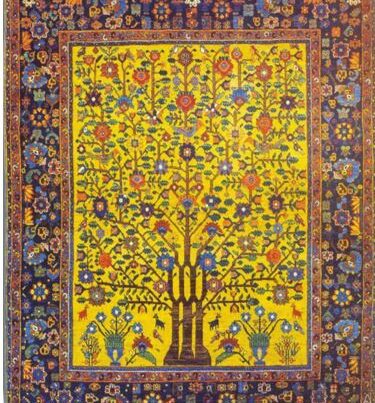FROM WITHIN On the Spiritual in Art and Architecture
Nader Ardalan
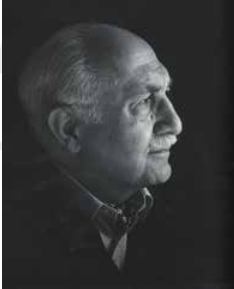
Nader Ardalan is President of Ardalan Associates, Consulting Architects in Boston. He is a Fellow of the Center for Middle Eastern Studies, Harvard University and the Director of the Gulf Research Project on Sustainable Design. He is the joint recipient of a recent Kennedy School Research Grant for 2010 entitled: The New Arab Urbanism in the Gulf.
Published in 2A Magazine Issue #12 – Autumn 2009
He is a recognized world leader and expert in the field of sustainable and culturally relevant planning and design. He has a close affiliation with the Aga Khan Award Programs in Architecture and has served as an international juror for numerous world competitions in the Middle East. He has held the position of Visiting Professor of Design at Harvard, Yale, MIT, Tehran University and lectures widely in international conferences and universities. He is the co-author of The Sense of Unity: The Sufi Tradition in Persian Architecture (University of Chicago Press) and many other publications.
The great epoch of the Spiritual which is already beginning, or, in embryonic form, began already yesterday… provides and will provide the soil in which a kind of monumental work of art must come to fruition.
– Wassily Kandinsky, 1912
We reach for the light spiritually, As the plant does physically
– Frank Lloyd Wright, 1914
Introduction
Countless generations of architects and artists have been inspired by the aesthetic quest offered by the spiritual dimension of existence that transcends life’s limitations and go beyond them. A long lineage of thinkers attempting to define these elusive dimensions can be traced in this field, which has variously been called Metaphysics, Mysticism, Sufism, Gnosis, Cabala, Zen, Yoga or the Esoteric Traditions. However, the topic has remained misunderstood by the majority of the public. Yet, its profound influence has permeated all aspects of the great literature, art, architecture, music and dance of the world in every age to various degrees. (Fig. 1 & 2)
This article will attempt to position this alternative world view, as particularly related to architecture and describe in summary the history and legitimacy of its root philosophic concepts. It will further discuss how in the beginning of the 20th C. the Abstract Expressionist Movement re-ignited the spiritual dimension in creative thought and re-invigorated key metaphysical and aesthetic principles that radically changed artistic and architectural expression. The contemporary application of this design approach through a systematic framework will be explored and demonstrated through some actual case studies. The article will conclude with observations about the potential value of this quest to shift architecture from the dominant, contemporary machine-inspired functionalist aesthetic to a more holistic, sustainability and spiritually inspired design approach.
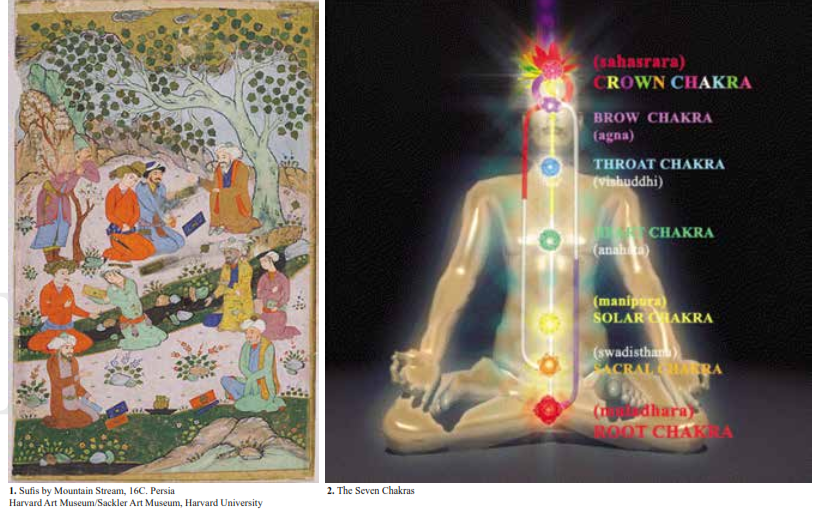
The Spiritual Quest
What is the history and structure of this spiritual quest in creative expression and how can it be described? The Western tradition can be traced from antiquity dating back to thinkers such as Hermes Trismegistus, Plato and Plotinus to the Middle Ages with leading figures including Meister Eckhart, Dante, Robert Fludd, Jakob Boehme, through to the 18th C. and 19th C. Emanuel Swedenborg, Goethe, William Blake, Ralph Waldo Emerson and to the 20th C. Theosophists, William James, Titus Burckhardt, Henri Corbin and Martin Heidegger’s Ontological Phenomenology.
Perhaps, for an even longer period of history in the East, the lineage of such quests might include Lao-tzu(1), Chuang-tzu, and the Ikhawan al Safa, Ibn Arabi, Rumi, Suhrawardi, Liu Zhi, through to Tagore, Ighbal, Gibran, to Coomaraswamy and S.H Nasr.
The term “transcendent aesthetics” is used here to describe the simultaneous awareness of the hidden and the manifest aspects of external reality. However, it requires a particular level of preparedness and awareness within both the artist and the beholder in regard to the beheld to comprehend and appreciate its message. The manifest is its phenomenal reality, while the hidden is its ontological link with its a priori non-existential reality. The artistic search to the deepest mysteries of the Way centers upon the personal and direct state of confrontation with reality in its broadest aspects, requiring no intermediaries. The resulting comprehension is usually characterized by a sense of the universe as a single,
living substance of which humans are an inseparable part.(2) Even if by this effort one is only able to catch but a brief and passing glimpse of an aspect of the non-articulated, the creative attempt is still inspiring and fulfilling. The creative challenge then is how to express most saliently the perfume of this glimpse.
This approach provides a peculiar kind of ‘field’ of consciousness or world view as the context for the ‘Creative Imagination’ to take place.(3) The activation of the Creative Imagination may be of an audible nature that transcends mere conventional tonal or linguistic frameworks through music, song, poetry or verse. In a similar manner, it may be of a visual nature in the form of light, color, art, architecture or movement. In both cases, the imagination is set into vibrations through abstract, transcendent symbols that have a propensity to pulsate the heart and thereby to touch the soul. (4) The soul serves here as the modus operandi within humans to spontaneously sense the ineffable and the sublime- to go beyond the mere phenomenal to higher levels of realizations about the realities of existence. This process has involved a symbolic and conscious death (fana) to the mere material way of perceiving existence and rebirth (bagha) to a heightened consciousness, where existence is perceived within a transcendent, ontological cause. Art, therefore, offers an opportunity not only as a vehicle of aesthetic satisfaction, but also a conduit between the microcosm of earthly existence and the macrocosm of everlasting spiritual existence. Such then is the nature and structure of this aesthetic quest. (Fig. 3)

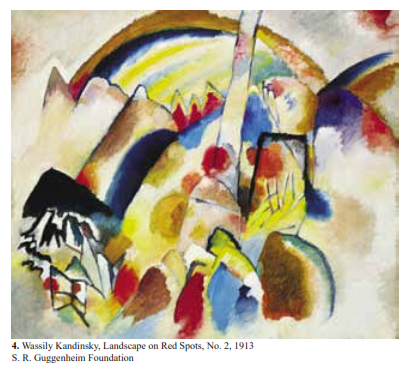
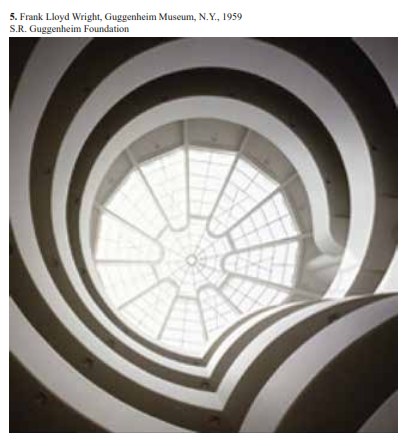
When you become the pencil in the hand of the infinite, When you are truly creative… design begins and never has an end.
-Frank Lloyd Wright, 1914
To Unfold the Human Soul
In the field of the arts, most notably from about 1890 in Northern Europe and later in the United States, a group of artists moved away from representational art toward abstraction, preferring instead symbolic color and form as their means of expression in an attempt to reach a higher and deeper dimension of meaning, the most pervasive of which was that of the spiritual. It coincided with the late nineteenth century reaction against what were thought to be limitations of the pervading rationalist and materialist world views of Western society (5). They held that the role of the artist was to free and reinvigorate modern painting with greater meaning. From that time to the early 1930’s, an astonishingly high proportion of visual artists and some architects became involved and worked with these ideas and belief systems, particularly after the devastations of WWI. Nourishing such directions of thought were lessons learned from such varied sources as Eastern mystics who had migrated to Europe; the introduction to African and “primitive art”; the theosophical and anthroposophical writings of Helena Blavatsky, Rudolf Steiner; the teachings of Gurdjieff; and the influential impact of the book On the Spiritual in Art by Kandinsky published in 1912. (Fig.4)
Robert Rosenbaum’s Modern Painting and the Northern Romantic Tradition-Friedrich to Rothko presents rather lucidly this northern European tradition which varied profoundly from the more French tradition in modern art of “Art for art sake”. In particular, he analyzed the quest of the sublime in art from the time of the artists Caspar David Friedrich to Van Gogh, through to Kandinsky to Rothko. How to express the spiritual experience outside the canons of organized religion became these artists’ prime search.
Maurice Tuchman’s essay in the Spiritual in Art: Abstract Painting 1890-1985 observes that: “The five underlying impulses within the spiritual-abstract nexus – cosmic imagery, vibrations, synesthesia, duality and sacred geometry- are in fact five structures that refer to the underlying modes of thought”.(6) To these should perhaps be added two more key impulses evident in their works. The first is a silent sense of the unity of existence – at Oneness with the infinity of the universe- which was a pervading theme of the earlier Transcendental Movement characteristic of the writings of Emerson and Walt Whitman in America that continued to influence many of these artists. This theme is also the core of the Wahdad-i-wujud (unity of existence) thinking attributed to the 12th C. Andalusian mystic Ibn Arabi that has had considerable and direct influence on later metaphysical contemplatives, including Emerson. The second is the appreciation of alchemy as a metaphor not only for the transmutation of external matter from its “dark heaviness to light”, but most importantly for the artist himself. The alchemical experience held for the artist the potential for a complete psychological catharsis that could both illuminate and purify the spirit.
Light releases the energy trapped in matter.
– Frank Lloyd Wright (7)
Alfred Barr, director of the Museum of Modern Art of New York, charted this artistic movement in his book
Cubism & Abstract Art (1936). He lauded, among others, the achievements and stature of Henri Matisse, Wassily Kandinsky, Piet Mondrian, Jean Arp, and DeChirico, to name a few. In the field of architecture and sculpture, this Western movement included such notable and foundational figures as Louis Sullivan, Frank Lloyd Wright, (8) Kazimir Malevich, Bruno Taut and Naum Gabo. Their creations reflect a desire to express spiritual, utopian or metaphysical ideals that cannot be expressed in traditional pictorial terms. (Fig. 5)
The Abstract Movement was criticized from many quarters on rational and political grounds in the years leading up to and including WWII. However, after this second cataclysmic world war, a new wave of particularly American artists sought to express a renewed urgency for asserting the universal truths of existence. Their spiritual sources tended not to be Theosophy, but beliefs and practices associated with Native Americans, Zen, Carl Gustav Jung’s concepts of archetypal form and world mythology as elucidated by Joseph Campbell. Abstract Expressionists such as Barnett Newman, Jackson Pollock, Mark Rothko and Georgia O’Keefe once again sought an art concerned with the sublime, silence and contemplation. (Fig. 6)
Architecturally, the great physical reconstruction of war-torn Europe and Japan overwhelmed any major impetus toward the transcendent in Architecture. Again it was Wright and those of his school of thought (such as Bruce Goff and Paolo Soleri in his own unique way) that practiced in this genre. One of the later, leading metaphysically inspired architects, much influenced by Wright was Louis I. Kahn, (9) who left few true disciples in America (perhaps architects such as Moshe Safdie, Daniel Libeskind and Antoine Predock) or in Europe (Carlo Scarpa, Mario Botta), while inspiring some Architects in the Middle East (the late Nader Khalili and this author) and in the Sub-continent, notably B.V. Doshi. Independent of Kahn’s influence, Hassan Fathy in Egypt generated a notable series of buildings based upon culturally relevant, transcendent considerations. More recently, Tadao Ando and Toyo Ito in Japan; Charles Correa in India; the late Anton Alberti of Holland; Peter Zumthor of Switzerland; and to some respect Santiago Calatrava from Spain are exploring dimensions of the phenomenology of the sublime in their architectural work. (Fig. 7)
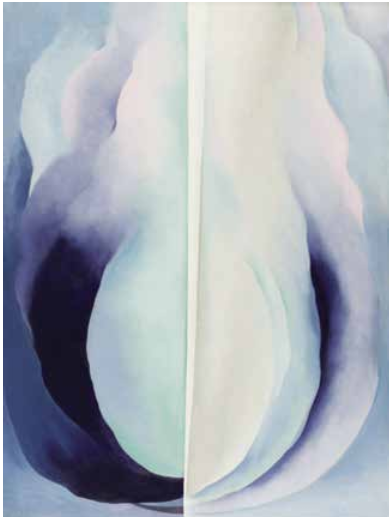
6. Georgia O’Keefe, Abstraction Blue, 1929
Museum of Modern Art
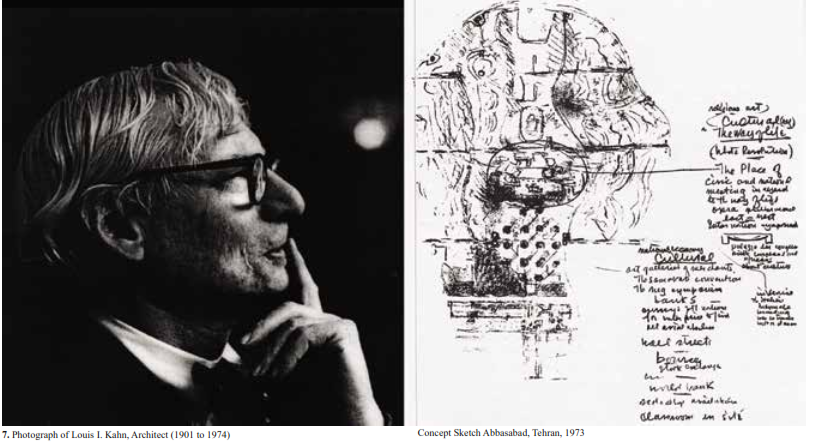
The Current Scene
During the past few years a number of international academic and professional conferences have been held dedicated to the subject of area of the relationship between nature, the built environment, culture and spirituality. (10)
Today, the urgency of this research subject has been greatly heightened by the apparent conjunction of three, potentially cataclysmic forces: the world economic crisis; global climate change; and the much debated clash of civilizations. The need, therefore, for yet another cycle of artistic and cultural expressions of the unity and sanctity of existence is evident.
This paper proposes a conceptual and general framework within which these diverse subjects might be holistically placed and common ground criteria established for their wholesome integration; thereby, allowing possible mitigating dialogue and constructive action to be taken. With respect to this essay, the context of geographic reference shall be the Middle East and its dynamic phenomenal and Islamic cultural situation.
In The “Sense of Unity”, published in 1973, I observed:” In the art and architecture of a traditional society the principles of the tradition inspire man’s creative energies and integrate the whole of society into a totality. In such a society the distinction usually made today between sacred and profane is either transcended by a metaphysical knowledge that pierces through all veils of separation or it is removed through (enlightened rational) integration of all aspects of life into a unity outside of which nothing exists. (11)
I shall briefly discuss this theme as it may pertain to our contemporary times. To begin with it should be remembered that Islam sustains a unified character of society while elaborating its exoteric and esoteric dimension. The exoteric dimension concerns social behavior and is inculcated in the Shariah, but is not directly related to the creative process. Rather, it is the metaphysical aspects of the Way (Tarigah) in which are found the principles which govern traditional Islamic art, especially architecture. Therefore, this quest shall be pursued through a frame of reference that contrasts the relationship between classic Western philosophical thinking based upon Cartesian Logic and traditional Metaphysics (Erfan) based upon contemplation and enlightened consciousness. It is important to note that recent scientific and academic research has shown that at the depth of key philosophic thinking there lies concealed a type of enlightened thought or heightened insight revealed by contemplative experiences. (12)
Expanding the Structure of Reality
Reason is modern man’s most dangerous illusion. – C. G. Jung
Your intuition is your most exacting sense; it is your
most reliable sense.
– Louis I. Kahn
Other recent signs in scholarly circles support this experiential knowledge approach, particularly in Martin Heidegger’s influential philosophical conceptions of Phenomenology that views “existence” only possible within an ontological and hermeneutical structure.(13) The noted French Iranologist, Henri Corbin, brilliantly compared the 20th Century philosophy of Heidegger to the 12th Century Persian Mystical conceptions of Suhrawardi, who ranked everything in existence according to the intensity of light it possesses. The Ultimate Source, the Light of Lights, is at the apex of this hierarchy at the bottom of which is existent matter and darkness. Suhrawardi holistically engaged in a “Trinal Knowledge, combining philosophy (Philos-loving + Sophos-wise = lover of wisdom), mysticism and logic. The resultant fruit of his quest, he termed “The Red Intellect” (Agl Surkh). (14) (Fig. 8)
It is this heightened ontological consciousness, symbolized by the Red Intellect, and here termed “Luminous Thinking” that is proposed as the sublime planning tool, sufficient in scope and grasp, to possibly generate a new holistic paradigm for our 21st. century challenges, especially in engaging the programming and design of the sustainable new habitats of the future. (Fig. 9)
In preparation for this Luminous Thinking approach, we need to first familiarize ourselves with some of the key principles of traditional design thinking of this culture. In particular, the significance of the conceptual use of space/time, form/surface, and light/matter are critical to our better understanding of the fundamentals involved in this timeless approach.
There is nothing more timely today than that truth which is timeless, than the message that comes from tradition and is relevant now because it has been relevant at all times. Seyyed Hossein Nasr, 21 C.

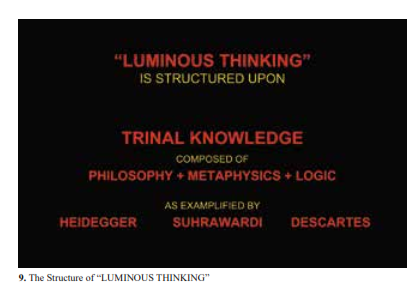
Positive Space
Traditionally, space has been viewed as one of the most direct symbols of Being. It is primordial, all pervading and in the cosmology of Islam, the “locus’ of the Universal Soul. This Hermetic concept forms a worldview in which the universe is composed of a microcosm and a macrocosm, each containing three great divisions: the body (jism), the soul (nafs) and the spirit (ruh). (15) (Fig. 10 & 11)
“T’was a fair orchard, full of trees, fruit, vines and greenery.
A Sufi there sat with eyes closed, his head upon his knee,
Sunk deep in meditation mystical.
“Why”, asked another, “Dost thou not behold
These signs of God the Merciful displayed
Around thee, which He bids us to contemplate?”
“The Signs,” he answered, “I behold within.
Without is naught but symbols of the Signs.”
– Rumi, 12th C. (16)
Here we are reminded that in the traditional metaphysical worldview, particularly in Islamic cultures, reality has two
structural dimensions, the “inner” (batin), understood by our enlightened thought and the “outer” (zahir) perceived by our sense receptors. Architecturally, the Walled Paradise Garden (bagh) and the Courtyard (hayat) with their inward spatial orientation have come to symbolize this duality in archetypal space making. From this view the very unique conception of “Positive Space” comes into play where Spiritualized Space, not exterior shape or object, is the dominant focus of this planning and design approach, as wondrously exhibited in the harmonic order of the bazaar Isfahan. (17) (Fig. 12 to 16)
The essence of organic building is space; space flowing outward, space flowing inward …
– Frank Lloyd Wright, 20th C.
Spiral Time
Unlike the classic Chinese conception of “Continuous Time” or the Greek conception of cyclical, “Circular time” or the orthodox Christian idea of “Linear Time” that begins with Genesis and moves progressively towards the Day of
Judgment and the Apocalypse, the Sufi Islamic conception of ”Spiral Time” commences with the Creation and through cyclical motion repeats the very act of creation, but in an ever ascending spiral, around an ontological axis, seeking ever higher levels of transcendence, illumination and ultimate union with the Absolute.
This brings us to one of the most remarkable realizations of this particular culture, termed Khalq Jadid or the “New Creation”. The “New” means a cyclical, transcending, timeless yet innovative manifestation of archetypal ideas. It is to this timeless world to which the late Master Architect Lou Kahn, in the Isfahan Conference, referred when he said:
“Traditions are just mounds of golden dust, not circumstance, not the shapes which have resulted as an expression in time….And if you can just put your fingers through this golden dust, you can have the powers of anticipation.”(18)






Were we wearied by the first creation?
Yet, they are uncertain about a new creation – Quran L: 14
Form/Surface
Geometry and number are the language by which form and surface define space. The Pythagorean system governs the traditional perception of the quantitative and qualitative understanding of mathematics. There is a batin or inner essence which distinguishes the zahir or external personalities of phenomenal shapes, surfaces and patterns that give symbolic meaning for their appropriate immanent (tashbih) and transcendent (tanzih) use.
(Fig. 17 to 19)
Naught there is but its treasures are with us and we send
It not down but in a known measure – Quran XV.21
Light Matter
The traditional craftsman associates himself with the transformation of matter and temporal creation through the science of Alchemy in order to transcend the ‘time bound’ materiality of the physical world. This Alchemical approach has a twofold aspect. On one hand, it deals with the transmutation of the soul of the artisan, while through the traditional arts and crafts, it is the science concerned with the processes of adapting to nature, the environment and the transformation of heavy matter to pure light as both aesthetic metaphor and phenomenal product. (Fig. 20)
All material in nature, the mountains and the streams and the air and we, Are made of light which has been spent, and this crumpled mass called material casts a shadow, and the shadow belongs to light – Louis I Kahn, 20th C.
A Proposed Holistic Framework
Based upon the preceding, the following conceptual framework is proposed which can form a matrix of design considerations that can qualitatively and quantitatively constitute a relevant and holistic structure to organize design thinking for the region of our focus, within its global context. Further, it may challenge the role of the architect to reinvigorate modern buildings and the built environment with deeper meaning.
(Fig. 21 to 22)


It is important to acknowledge that cutting across all other issues facing the world is climate change. Its practical, economic and elegant mitigation by designing environmentally and culturally Sustainable Built Environments inspired by a Transcendent Vision is our greatest challenge.
Regrettably, it has been demonstrated by the UN IPCC 2007 Assessment Report on Climate Change that current planning, design, construction and real estate practices and building models that are being used in the developed and developing countries, including this region, demonstrate serious shortcomings that are jeopardizing the planet. This is based upon the theory that increased levels of carbon dioxide and certain other gases are causing an unstable increase in the average temperature of the earth’s atmosphere. The specific causes are high fossil fuel and other resource and water consumption, urban sprawl, pollution and traffic congestion that have also resulted in a loss of the quality of urban life and social cohesion plus lacking an indigenous sense of cultural identity. (19)
First Axis- Transcendence
Archetypes are the essential forms (suwar) of the Divine Names.
All things in phenomenal world come into existence depending upon the level of preparedness to meet the essence of their Archetype. – Toshihiko Izutsu, 20th C.
Inspired by the spiritual and poetic traditions of Islam, a vertical hierarchy of manifestation can be considered that
transcends on an Ontological Axis from the measurable world of Phenomenal Existence (Nature/Man) through the World of Traditional Forms (the Typal) and beyond to the World of Archetypes, and on to the Divine Names that ultimately leads to the immeasurable, transcendent Universal Source, The Absolute, The Divine. In the view of Ibn Arabi: “All causality (the self-externalization of the Divine, in Arabic Tajalli) is in the Divine Names, in the incessant renewal of their epiphanies from instant to instant”.(20) This important Axis brings the spiritual dimension of design and planning into our consciousness, which for far too long has been over shadowed by to the Post-Renaissance Materialist Determinism Philosophical World View. (Fig. 23 to 24)
The Divine was a hidden treasure that wished to be known,
Therefore, he created the world
– Hadith of the Prophet, 7th C.
Second Axis- Scale
In Planning/Design terms the Horizontal Axis commences at the scale of the Individual and the smallest building unit-the Dwelling- and moving outward to the social Cluster of dwelling units, to the Pedestrian Precinct and to the Urban Community and finally encompasses the Regional Domain. Criteria for each of these scales have been thoroughly researched over the years. One of the notable contributions on this topic was made by Iran to the first United Nations Conference on Human Settlements held in Vancouver, Canada in 1976 entitled the “Habitat Bill of Rights”. (21) (Fig. 25)
Third Axis-The Bio-Climatic Cultural
Scientists and sociologists have determined that the world can be categorized into eight bio-climatic ecological zones, ranging from the Tundra to the Tropical Forests, as determined by their temperature and geographic hydrological gradients in proximity to the sun. The Third Axis pivots around the Ontological Axis generating eight branches of the World Bio-Climatic Cultural Zones, each with their respective sub-zones.
(Fig. 26 to 27)
When applied to a specific country, such as Iran when we were commissioned to Master Plan the Pardisan Environmental Park Project for Tehran, it was realized that Iran through its’ vast territory contains six of the eight world biomes. When these zones are layered by the characteristic, indigenous cultural types, a fine grain of bio-climatic cultural definition of the country was obtained. Within this framework, it would be possible to develop optimum criteria for excellence in passive design principles that are also cultural relevant that could minimize energy demand in the various regions. Compared to many existing ”Business as Usual” developments now prevalent in Iran and the region that exhibit high energy demand, a more sustainable strategy, possibly based upon “One Planet Living”-10 Principles, could conceptually reduce significantly the current energy demands of our towns and cities. The benefits would be more economical and culturally more sustainable habitats, imbued with a meaningful identity of place. (22)
(Fig. 28)
Tree of Life
The resultant conical form created by these three axes can be viewed as a “Tree of Life”, representing the multiplicity within the unity of the world based upon a central, transcendent cause. This conceptual framework can form a matrix of design guidelines that can qualitatively and quantitatively direct a holistic sustainable design process.
Metaphorically in reference to the history of literature, art and poetic references in the Middle East, the tree can also be viewed as a Cypress (Sarv), which has symbolized longevity of life, self- fertilization, freedom and sustainability.




Applications of the Theory- Case Studies
Six case studies of actual project designs based upon the above holistic theories of sustainable design, commencing from the early 1970’s and continuing to the present, can help demonstrate the efficacy and benefits of the ”Tree of Life” Framework of Design, based upon a “Luminous Thinking” approach.
Imam Sadegh University (Iran Center for Management Studies) – Tehran
Designed in 1971 as a Design Partner of AFFA, using the functional curriculum of a graduate school of business in cooperation with Harvard University, but based in architectural design upon the archetypal concept of a traditional Persian Paradise Garden, a traditional Madrasah and the Principles of Positive Space Continuity, the design survives today after nearly four decades in a most sustainable way, both physically and culturally, while serving the new functions of the Imam Sadegh University.(Fig. 29 to 30)
Nuran – City of Illumination – Isfahan
Although never implemented, the Master Plan and Concept Design of Nuran was planned in 1978 and recognized by MIT as one of the first low-carbon Solar Energy based cities in the world. This city of 100,000 population located in the vicinity of Isfahan was so oriented that its central town axis was on direct alignment with the great Blue Dome of Masjid-i-Imam. Solar ponds, Photovoltaic roof panels, locally sourced cyclopean concrete structures, compact, high density mixed-
use design characterized this pedestrian oriented garden city. (Fig. 31 to 32)
Desert Retreat – UAE
In 2007 when thinking about the Desert Retreat, an intimate, private extended family place for a UAE National in the remote deserts of that country, I came to the conclusion that what can be valuable in the design theme and its architecture is to set a high standard of archetypal significance. Not just to repeat the historic “pastiche” version of traditional architecture, nor the aseptic “Avant Garde’ devoid of culture, but to search for what Joseph Campbell called the “Monomythic” and primordial common ground narratives of space, time, forms, signs and symbols from the region and around the world to be realized in a unified New Creation of traditional values and contemporary opportunities.
In keeping with the essential nature of the site, the retreat is to be constructed of architectural concrete made from the red sand of the site, washed and blended with exposed aggregates from the adjacent Hajar Mountains to alleviate its visual heaviness. Teak and sandstone completed the material palette that complements the ecologically adapted oasis landscape selection. The place should evoke a primordial sense of the origins of mankind, somewhat as the historic remains of the region give one the awe inspiring sensation of ancient beginnings. (Fig.33 to 36)
Abu Dhabi Ecological Park, UAE
A multi-disciplinary US team was commissioned by Aldar Properties, one of the leading development companies of Abu Dhabi in 2008 to master plan and concept design a Model Sustainable, low-carbon Community of 7,500 populations in Abu Dhabi on a 32 hectare site that would also serve as the Gateway to the Wetlands National Park of this desert island city. This project is based upon World Wildlife Fund, One Planet Living Principles, LEED Guidelines and Alternative Energy Sources. The Client in concert with the Consultants agreed that four key forces should generate the project design:
Environmental Sustainability; Cultural Relevance; Financial Viability and a Visionary Architecture of Innovative Significance
The First Phase of studies have already demonstrated environmentally adapted design strategies that reduce energy demand by 60% compared to BaU and provide renewable energy sources from vast, roof canopies of thin-film photovoltaic’s, while providing shade for buildings, urban spaces and creating desirable microclimatic conditions.
(Fig. 37 to 45)
The Intelligent Tower- Doha, Qatar
The new typology of a sustainable high-rise architecture presents a significant design challenge. Our 2007 entry in a world design competition was awarded first place and the professional design contract. The 70 story tower, located on the West Bay Corniche of Doha, will provide an environmentally adapted, socially friendly and sustainable “Place for Business”. The tower minimizes energy demand by its high performance envelope of three layers of glass with a sun protecting movable shade and spawns innovative energy production through wind and solar and energy efficient technologies while creating a dramatic, cultural symbol of an “Eternal Tree”- the Cypress. (Fig. 46 to 50)
Conclusions
To truly understand sustainable design, we need to begin with a culturally attuned cosmic, systemic awareness of the context and physiology of human existence on both a phenomenal and spiritual level. The Holistic Framework (The Tree of Life) that has been proposed herein can form the basis of a mandate of good design that is capable of beautifully reflecting this poetic vision with contemporary means, thereby transporting the beholder beyond material existence. The outstanding history and achievement of significant architectural and city building in this ancient land demands nothing less of it’s decision makers and it’s glorious people.
There is a desperate urge to unity by the whole of one’s being to integrate its parts and by the parts to merge with the whole, without which there would be no love, worship or affirmation, the consummation of which is in the Oneness of Being.
-Muhyi al-Din Ibn al-Arabi, 12 C.
There is no intuitive certainty until you burn:
If you desire that certainty, set down in the fire!
– Rumi, 12C.
1. Lao-Tzu- “The Tao that can be told is not the eternal Tao.
The name that can be named is not the eternal name.
The nameless is the beginning of heaven and earth.
The named is the mother of the ten thousand things.
Ever desireless, one can see the mystery.
Ever desiring, one can see the manifestation.”
2. See Lovelock, James. The Ages of Gaia, a Biography of our Living Earth. Oxford and New York; Oxford Press, 2000.
3. See Izutsu, Toshihiko and Toyo. The Theory of Beauty in the Classical Aesthetics of Japan.
The Hague/Boston/London: Martinus Nijhoff Publishers, 1981.
4. Kandinsky, Wassily. On the Spiritual in Art. Munich: R. Piper & Co., 1912
5. Regier, Kathleen J. The Spiritual Image in Modern Art. Madras/London: A Quest Book, 1987.
6. Los Angeles County Museum of Art. The Spiritual in Art-Abstract Painting 1890-1985.New York/London/Paris: Abbeville Press, 1986.
7. Hoppen, Donald W. Seven Ages of Frank Lloyd Wright. New York: Dover Press, 1998.
8. See Hoppen. Seven Ages of Frank Lloyd Wright. F.L. Wright’s marriage to Olgivanna in 1928 introduced Wright to the teachings of the mystic Gurdjieff, who had a strong influence on her and subsequently on Wright and the Taliesin Fellowship. This complemented the pre-existing influences of Whitman, Thoreau and Lao-Tzu on Wright.
9. See Lobell, John. Between Silence and Light- Spirit in the Architecture of Louis I. Kahn.
Boulder: Shambala, 1979. Louis Kahn: “The poet is one who starts from the seat of the unmeasurable and travels toward the measurable, but who keeps the force of the unmeasurable within him at all times.”
10. These include: “Making Sacred Places,” Built Form and Culture Research Conference, (University of Cincinnati, 1997); “Pilgrimage and Complexity,” (Indira Gandhi National Centre for the Arts, New Delhi, 1997); “Space, Place & Spirituality in the Built Environment,” (Ball State University, 1999); Constructing the Ineffable. Contemporary Sacred Architecture (Yale University, October 2007); Research Symposium: Paradoxes of Appearances (Copenhagen, Denmark) 9-11 June 2008; The Symposium on Architecture, Culture and Spirituality (Mt. Angel Abbey, Oregon, 2008); “Traces of the Spiritual” Art exhibit at the Haus der Kunst Museum Munich, (Germany) 19 Sept 2008 -11 January 2009.
11. Ardalan, Nader & Bakhtiar, Laleh. The Sense of Unity, the Sufi Tradition in Persian Architecture. Chicago and London; Chicago University Press, 1973.
12. Beauregard, Mario & O’Leary, Denyse. The Spiritual Brain, a Neuroscientist’s Case for the Existence of the Soul. New York: HarperCollins Publishers, 2008.
13. See Corbin, Henry. “From Heidegger to Suhrawardi”, Interview with Philip Nemo, recorded for Radio France-Culture, 1976.
14. The Mystical & Visionary Treatises of Shihabuddin Yahya Suhrawardi, translated by
Wheeler. M. Thackston, Jr., London: The Octagon Press, 1982.
15. See Ardalan & Bakhtiar, The Sense of Unity.
16. Rumi, Poet and Mystic. Translated by R.A. Nicholson. London:
George Allen and Unwin, 1964.
17. See Ardalan and Bakhtiar, The Sense of Unity.
18. The Interaction of Tradition & Technology, Report of the Proceedings of the First International Congress of Architects, Isfahan. Ministry of Housing & Urban Development, Government of Iran, 1970.
19. Climate Change 2007, IPCC Fourth Assessment Report, United Nations. London: Cambridge University Press, 2007.
20. Corbin, Henri. Creative Imagination in the Sufism of Ibn Arabi. Princeton: Princeton University Press, 1969.
21. The Habitat Bill of Rights. Ministry of Housing & Urban Development, Government of Iran, Editors: Nader Ardalan, Jose Luis Sert, Moshe Safdie. George Candilis & B.V. Doshi, 1976.
In 1974, The Ministry of Housing and Urban Development of Iran convened the Second International Congress of Architecture at Persepolis. At the conclusion of the Congress the delegates passed the following Resolution:
“Through research studies, a code of human habitat should be developed with such procedures and strategies necessary to the achievement of principles essential to the creation of a wholesome, balanced and equitable habitat. This code should be so prepared that it may form a working tool suitable for use by all the decision makers involved in the shaping of the human habitat in time and place.”
An international team of architects and professors from some of the leading schools of architecture worked on a volunteer basis over one year to prepare this document. It was entitled the “Habitat Bill of Rights” and presented to the first Habitat Conference. The New York Times June 8, 1976 headline on the conference read: “Architects Have a Blueprint for Habitat” and featured the Iran contribution that emphasized “human scale and modest, vernacular architecture as opposed to the often abstract quality of much modern design, particularly as expressed in government-built housing” . Recently it has been translated and republished in Farsi by IAARA.
22. Pardisan, Plan for an Environmental Park in Tehran. Department of the Environment, Government of Iran. The Mandala Collaborative/WHRT, 1975.

